For years I've assumed that one of mankind's greatest fantasies has been to develop a practical, personal jetpack. But if the covers of Popular Science serve as any measure for this sort of thing, then it seems that for the past few decades man's been dreaming less about rocketing through the sky than he has about riding in some kind of giant wheel.
The revelation struck me as I was skimming Google's new archive of Popular Science and Popular Mechanics magazines for interesting cover art. As I quickly realized, the magazines' covers featured some crazy new vehicle every few years eschewing the apparently pesky and cumbersome multiwheel concept in favor of one enormous gyre.
Of course, once I noticed the pattern, I had to go back and scan all the issues methodically to see just how many variations have appeared over the generations.
April 1914 – The Air-Propelled Unicycle
The earliest example I could uncover of the giant-wheel conveyance within the annals of PopSci and PopMech appeared in 1914, and if I'm not mistaken, it's the only one to grace the cover of Popular Mechanics in its 103-year history.
According to the accompanying article, the St. Louis, Missouri-based "air-propelled unicycle" could reach a speed of 67 miles per hour with the help of a 5-foot propeller. The ring, made of aluminum, was almost 7 feet in diameter and supported a 2-inch solid-rubber tire. Though the driver grasped what appeared to be a steering wheel, all steering was accomplished by leaning. When not in motion, four narrow skids kept the whole thing from falling over.
September 1917 – D'Harlingue's Air-Propelled Unicycle
As far as I can tell, this was the first Popular Science cover to appear in color and, lo and behold, it featured another version of the "air-propelled unicycle."
This time the inventor was named as A.F. D'Harlingue, although no further information is given about the man. His version of the vehicle, measuring 9 to 10 feet in diameter, is more complicated than the one above, employing more mechanics, as well as a small wheel in front to assist in steering, although only at low speeds. This one also differs from all the others in that the rider is clumsily placed outside the wheel.
PopSci unequivocally dismissed the whole design as awkward and inefficient.
April 1923 – The Christie Monowheel
This cover from April 1923 features an enormous, spoke-covered terror conceived by one Professor E.J. Christie from Ohio. An astounding 14 feet tall, it was designed to employ two inner wheels that acted both as rudders and as gyroscopic stabilizers.
A 250-horsepower airplane engine was used for forward locomotion, positioned well below the driver's seat, the weight of which supposedly helped to prevent the operator from turning end over end within the wheel. Christie claimed speeds reaching 250 miles per hour, with a potential for 400 miles per hour, although neither was likely.
December 1924 – The Velocita a.k.a. the Motor-Mota
Referred to informally by Popular Science as a "motor-hoop," this version was invented by an Italian police officer named Davide Gislaghi.
Essentially, Gislaghi's design traveled on an endlessly looped track. He ditched the propeller that mobilized previous designs and engineered it to function more like a motorcycle. All moving components were attached to an inner circle that was separated by rollers from an outer tire.
The upright orientation of the driver was maintained mostly by the weight of the engine. The steering wheel tilted the central frame, using the driver's weight to steer. According to the November 1933 article below, the gas version could reach 100 miles per hour and cover 280 miles on one gallon.
When Gislaghi completed his Velocita, he drove it from Milan to Rome, then raced it around the National Stadium to win a wager against those who said it wouldn't work.
Reportedly, designs similar to this one date back as far as 1904, and people are still making them today.
May 1932 – The Dynasphere
Not to be confused with the Dinesphere, this bagel of a monowheel was designed by Englishman Dr. J.H. Purves to be what he believed was locomotion reduced to its simplest possible form.
Purves built at least two Dynaspheres — or Dynospheres, according to some sources — the first a 10-foot gas-driven wheel, the second a smaller, electrically powered version. The wheel was curved as though sliced from a sphere, which allowed the driver to steer by shifting his weight from side to side, tilting the whole wheel. In an upcoming version, steering was to be accomplished by shifting the entire cabin mechanically. The outer shell was constructed from an iron lattice that one can only assume left a giant waffle pattern in the asphalt. The cobra hood was presumably just part of the sport package.
Here's a video of the Dynasphere in action:
November 1933 – The One-Man War Tank
I was all ready to honor this one with the Most Awesome Wheel Award, but the related article barely mentions it. The majority of the write-up actually covers a military adaptation of the design, devised by an unnamed New York inventor.
Still, the description is rather fascinating. "Suddenly, through the drifting smoke of a hard-fought battle," reads the article, "rush weird, one-man fighting tanks." Enclosed in a steel clamshell, the driver peered out through a porthole to fire his built-in machine gun. Two training wheels were designed to steer and stabilize the craft as it rushed across the battlefield while two extendable "crutches" would drive into the ground to help it vault over obstacles. By attaching fins and inverting the rear wheels' "pants," the unicycle could roll across water.
The wheel on the cover is an "open-type form of the vehicle ... without the armored body or the crutches ... designed for highway use."
September 1938 – The Water-Wheel
"Water-wheel racing is new beach sport," announces the title of this surprisingly-short-to-warrant-the-front-page article.
"Propelled in squirrel-cage fashion," these buoyant, non-motorized wheels are the only examples that make no predictions as to their potential to change the future of travel. Driven by Herculean men in skin-tight shorts, they're designed entirely for waterborne recreation and, according to the article, were rapidly gaining popularity at European resorts at the time.
May 2007 – The Snap Multicar
After a hiatus of nearly 70 years, and 20 minutes of increasingly disappointing cover scanning on my part, the big-wheel design finally makes a return appearance in the 21st century.
Making the list of PopSci's wish list of cars for 2027, this modern adaptation of the motorized unicycle rides on two runners that steer by varying their relative rotational speeds or, during faster travel, by the age-old method of pitching side to side. Balance is maintained with accelerometers and gyroscopic sensors.
The real innovation, though, is the pod's ability to physically link up with other pods to create a complete sedan, then separate again to reach divergent destinations.
Honorable Mentions
A few of the contraptions I came across, while falling into the same general "giant wheel" genus, didn't pass my criteria for inclusion in the list above, arbitrary as those criteria might have been.
Nevertheless, due either to their distinctiveness or to their indismissible ridiculosity, I couldn't bring myself to leave them out entirely.
September 1933 – Dandini's Marine Vessel
Making PopSci's "chronicle of queer ideas," this one is perhaps the most ridiculously complicated monowheel vehicle ever conceived. The giant, fin-covered globe was intended to float on a body of water while a diesel engine rolled inside it like a hamster in a hamster ball. Steering was to be accomplished using propellers on either side of the globe, as well as rudders on the external airplane-like fuselage, in which the vessel's passengers would ride. The arms that attached the fuselage to the globe contained stairways that provided access to the globe's interior, though for reasons unknown.
July 1936 – The Tumbleweed Tank
Similar to Dandini's vessel above, this ball employed an internal motor and external traction cleats to propel it along. In this case, however, the passengers were crammed inside the sphere itself, along with the engine. The outer shell was split into two hemispheres, leaving stationary sections on the sides and vertically around the middle, through which its passengers could fire guns. Its inventor, A.J. Richardson, patented the idea as a combined "autoball and armored ball."
December 1962 – The Goodyear Space Station
Now, this was the ultimate in big-wheel technology. It is the quintessential space station, just as it's appeared in countless midcentury movies and illustrations. Shaped like a doughnut, it was designed to rotate at a given speed to create an artificial gravity inside the outer rim. Goodyear actually built a prototype of this design 30 feet in diameter, which was to be scaled up to 150 feet for use in orbit. Sadly, however, neither it nor any other version of the toroidal space station has ever been employed outside the realm of science fiction.
The Monowheel Phenomenon
The history of the single-wheel device extends well beyond those featured by Popular Science and Popular Mechanics. Today, such designs are referred to collectively as "monowheels."
For a more complete history of the monowheel, including early pedal-powered designs as well as those being built today, check out the Museum of Retro Technology.




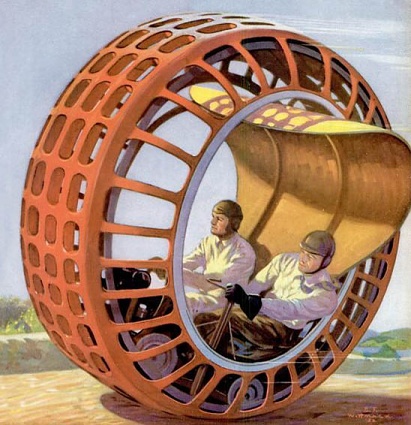
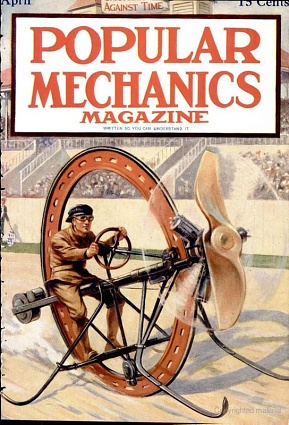
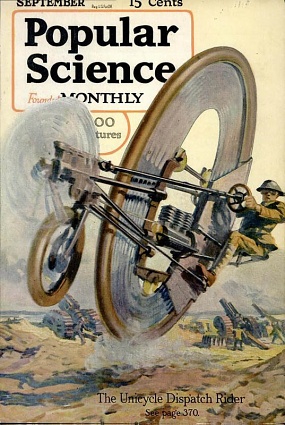
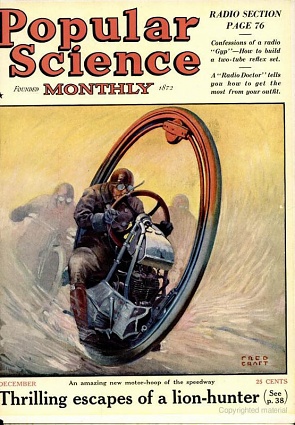
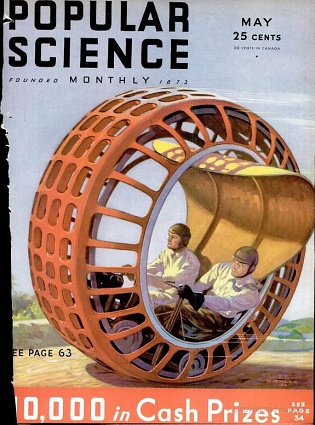
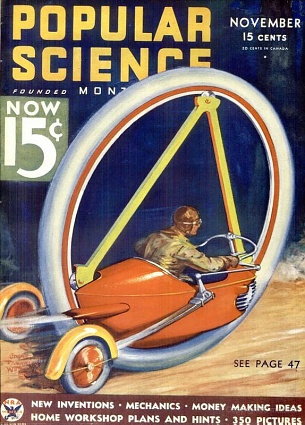
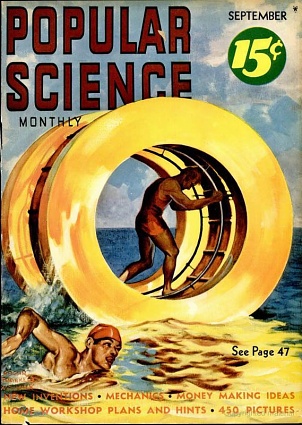
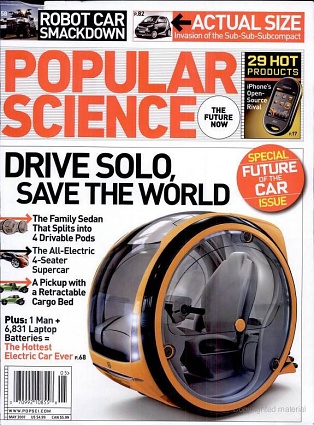
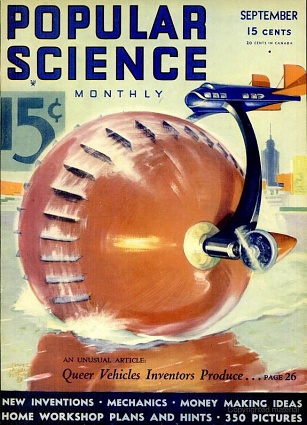
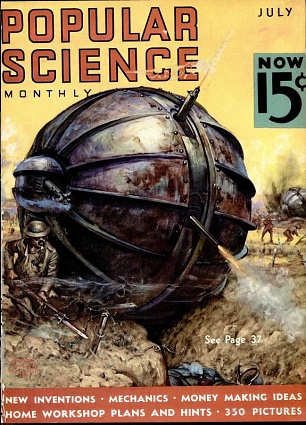
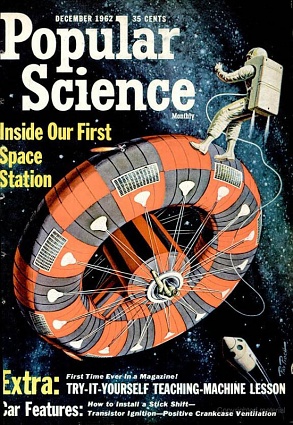
1 Comment
There are more than seen here! For example, http://blog.modernmechanix.com/2006/01/page/2/ (about halfway down the column) shows the June 1935 cover of [b]Modern Mechanix and Inventions[/b], and has a bonus article just below for the honorable mentions. This one is another Honorable Mention type, but can't tell the year: http://www.pulpartists.com/Bio%20Materials/Rozen,%....